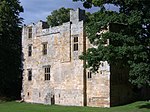Slaley, Northumberland

Slaley is a village in Northumberland, England. It is situated to the southeast of Hexham. It is surrounded by the following villages: Ruffside, Whitley Chapel, Ordley, Wooley, Healey, Juniper, Riding Lea, and Blanchland.The parish church is dedicated to St Mary the Virgin. The present church dates from 1832 (with extensive repairs in 1907-8) and was designed by Milton Carr. It stands on the site of an earlier church built in 1312, and that church was built on an earlier church mentioned in 1239 when Gilbert de Sclaueley gave the church and some lands to the prior of Hexham.The nearby hamlet of Shield Hall has the remains of a medieval unfortified house (late 13th/early 14th century). It has been incorporated into the early 19th century farmhouse. The nearby hamlet of Dukesfield is mentioned in 1256 as the scene of a murder. The area was part of the barony of Bolbec. In 1834 lead mining and smelting began. Dukefield Hall is a listed building. To the north of the village there is a disused nuclear bunker. The bunker was opened in 1961 and closed 1991.
Excerpt from the Wikipedia article Slaley, Northumberland (License: CC BY-SA 3.0, Authors, Images).Slaley, Northumberland
Geographical coordinates (GPS) Address Nearby Places Show on map
Geographical coordinates (GPS)
| Latitude | Longitude |
|---|---|
| N 54.914 ° | E -2.037 ° |
Address
NE47 0AA
England, United Kingdom
Open on Google Maps








